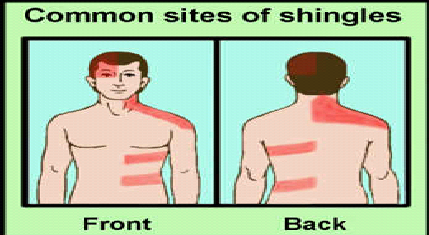
What Do You Know About Shingles?
Shingles is a viral infection that causes a painful rash. Although shingles can occur anywhere on your body, it most often appears as a single stripe of blisters that wraps around either the left or the right side of your torso. Shingles is caused by the varicella-zoster virus — the same virus that causes chickenpox. After you have had chickenpox, the virus lies inactive in nerve tissue near your spinal cord and brain. Years later, the virus may reactivate as shingles.Shingles usually appears in a band, a strip, or a small area on one side of the face or body. It is also known as herpes zoster.
It is not clear why this happens- Shingles occurs when the virus that causes chickenpox starts up again in your body. After you get better from chickenpox, the virus “sleeps” (is dormant) in your nerve roots. In some people, it stays dormant forever. In others, the virus “wakes up” when disease, stress, or aging weakens the immune system. Some medicines may trigger the virus to wake up and cause a shingles rash.
While it is not a life-threatening condition, shingles can be very painful. Vaccines can help reduce the risk of shingles, while early treatment can help shorten a shingles infection and lessen the chance of complications.
You cannot catch shingles from someone else who has shingles. But there is a small chance that a person with a shingles rash can spread the virus to another person who hasn’t had chickenpox and who hasn’t gotten the chickenpox vaccine.
Symptoms: Shingles symptoms happen in stages.
Shingles develops painful rash that develops on one side of the face or body. The rash forms blisters that typically scab over in 7 to 10 days and clears up within 2 to 4 weeks.
Before the rash develops, people often have pain, itching, or tingling in the area where the rash will develop. This may happen anywhere from 1 to 5 days before the rash appears.
Most commonly, the rash occurs in a single stripe around either the left or the right side of the body. In other cases, the rash occurs on one side of the face. In rare cases (usually among people with weakened immune systems), the rash may be more widespread and look similar to a chickenpox rash. Shingles can affect the eye and cause loss of vision.
- Pain, itching, or tingling of the skin followed by a painful rash of blister-like sores, usually on one side of the body, often on the face or torso
- Fever
- Headache
- Chills
- Upset stomach
Who gets shingles?
Those at higher risk are people who:
- Are 50 and older
- Have HIV infection or AIDS
- Have cancer
- Have had chemotherapy or radiation treatment
- Have had organ transplants
- Are taking certain medications, like corticosteroids
- Are under increased stress
Complications:
The most common complication of shingles is a condition called post-herpetic neuralgia (PHN). People with PHN have severe pain in the areas where they had the shingles rash, even after the rash clears up.
The pain from PHN may be severe and debilitating, but it usually resolves in a few weeks or months in most patients. Some people can have pain from PHN for many years.
As people get older, they are more likely to develop PHN, and the pain is more likely to be severe. PHN occurs rarely among people under 40 years of age but can occur in up to a third of untreated people who are 60 years of age and older.
Shingles may lead to serious complications involving the eye. Very rarely, shingles can also lead to pneumonia, hearing problems, blindness, brain inflammation (encephalitis) or death.
Treatment and remedies:
CDC recommends that adults 60 years old or older receive one dose of the shingles vaccine. The vaccine reduces the risk of developing shingles and the complications caused by the disease. The only way to reduce the risk of developing shingles and the long-term pain from post-herpetic neuralgia (PHN) is to get vaccinated.
Several antiviral medicines—acyclovir, valacyclovir, and famciclovir—are available to treat shingles. These medicines will help shorten the length and severity of the illness. But to be effective, they must be started as soon as possible after the rash appears. Thus, people who have or think they might have shingles should call their healthcare provider as soon as possible to discuss treatment options.
Analgesics (pain medicine) may help relieve the pain caused by shingles. Wet compresses, calamine lotion, and colloidal oatmeal baths may help relieve some of the itching.
Disclaimer: This article is meant for educational purpose only. If you or people around you shows symptoms of this condition please contact your physician.
Reference:
http://www.everydayhealth.com/
http://www.mayoclinic.org/
http://www.webmd.com/
http://www.cdc.gov/
Image courtesy: http://www.moondragon.org/health/graphics/shinglescommonsites.jpg
Author: Sumana Rao | Posted on: October 9, 2015
« Super Brain Yoga (Tappu Karnam) Breathing Exercise to keep Your Mind & Body in Harmony »






















Write a comment